ADP Workforce Now Integration
Contents
- What can you do with a Dado-ADP integration?
- What data is exchanged between Dado and ADP?
- How to set up the ADP integration via the ADP API
- How to set up the ADP integration without ADP API access
- Step 1. Get credentials from Dado
- Step 2. Create an ADP profile with access to reports
- Step 3. Create a new ADP user and assign it to your "Integration Services Account" profile
- Step 4. Connect the service account user to the service account profile you just created
- Step 5. Return to Dado to authenticate
- Troubleshooting the ADP non-API integration
What can you do with a Dado-ADP Workforce Now integration?
The Dado <> ADP Integration allows you to:
- use ADP as a source for importing users and updating user data
- let employees answer questions in Dado and sync the answers to the employee's ADP profile
What data is exchanged between Dado and ADP Workforce Now?
ADP data accessible to Dado:
Dado connects to ADP via their API, and so in theory can access a large amount of data about your employees. In practice, which data is synced to Dado is determined by you, when you set up ADP as an import source and select which fields should be imported.
Once the integration is set up, Dado will import data for all users in ADP. That means it is not possible to restrict Dado's access to a subset of the users in ADP.
Dado data accessible to ADP:
By default, no Dado data is accessible to ADP.
You can choose to set data collected via 'Answer question', 'Choose option' or 'Provide address' sub-tasks to sync back to ADP, to a field that you specify, via Dado's Data Destinations feature.
How to set up the ADP integration via the ADP API
Step 1. Request API credentials from ADP
Contact your ADP account manager to request the following credentials:
- Client ID
- Client Secret
- SSL Client Certificate
- SSL Client Key
Step 2. Set up the integration in Dado
- Go to Settings > Integrations in your Dado account. Click on the ADP card.
- Enter the ADP API credentials you received from your account manager
- Click save.
- It may take a few seconds to finalize the connection with ADP. The connection has been successfully set up when you're returned to the Integrations page.
You're now ready to set up ADP as an import source, and start importing data into Dado!
How to set up the ADP integration without ADP API access
It's possible to sync data from ADP to Dado without ADP API access, by creating a practitioner role within ADP Workforce Now to link your account.
Time required: 45 minutes
Pre-requisites: an Administrator account in your ADP instance.
Step 1. Get credentials from Dado
When you set up your practitioner role in ADP, you will need to use a username and password specified by Dado.
- Go to Settings > Integrations in your Dado account
- Click on the ADP Workforce Now (non-API) card
Make a note of the details shown in the window (or leave the tab open as you do the next steps)

Step 2. Create an ADP profile with access to reports
1. In your ADP Workforce Now account, go to Setup and find Access Permissions.

2. Then click Manage Profiles > Create Profile

- Enter the following details:
- Name: Integration Services Account
- Role: Practitioner

- Clicking Create profile in the previous step will open up a new screen. In Menus & Features, go to Reports & Analytics to make sure the following boxes are checked.
- My Reports
- All Reports
- My Standard Reports
- View
- Reports Output
- Reports Scheduled
- Reports Dashboard
- All Reports (only grants access to report types that are otherwise checked)
- Personal & Employment
- Reports Dashboard
- Reports Dashboard
- Standard Reports
- All Reports (only grants access to report types that are otherwise checked)
- Personal & Employment
- My Reports

- Next, go to People and make sure these boxes are checked.
- Employee Profile Report
- Employment Profile
Personal Profile
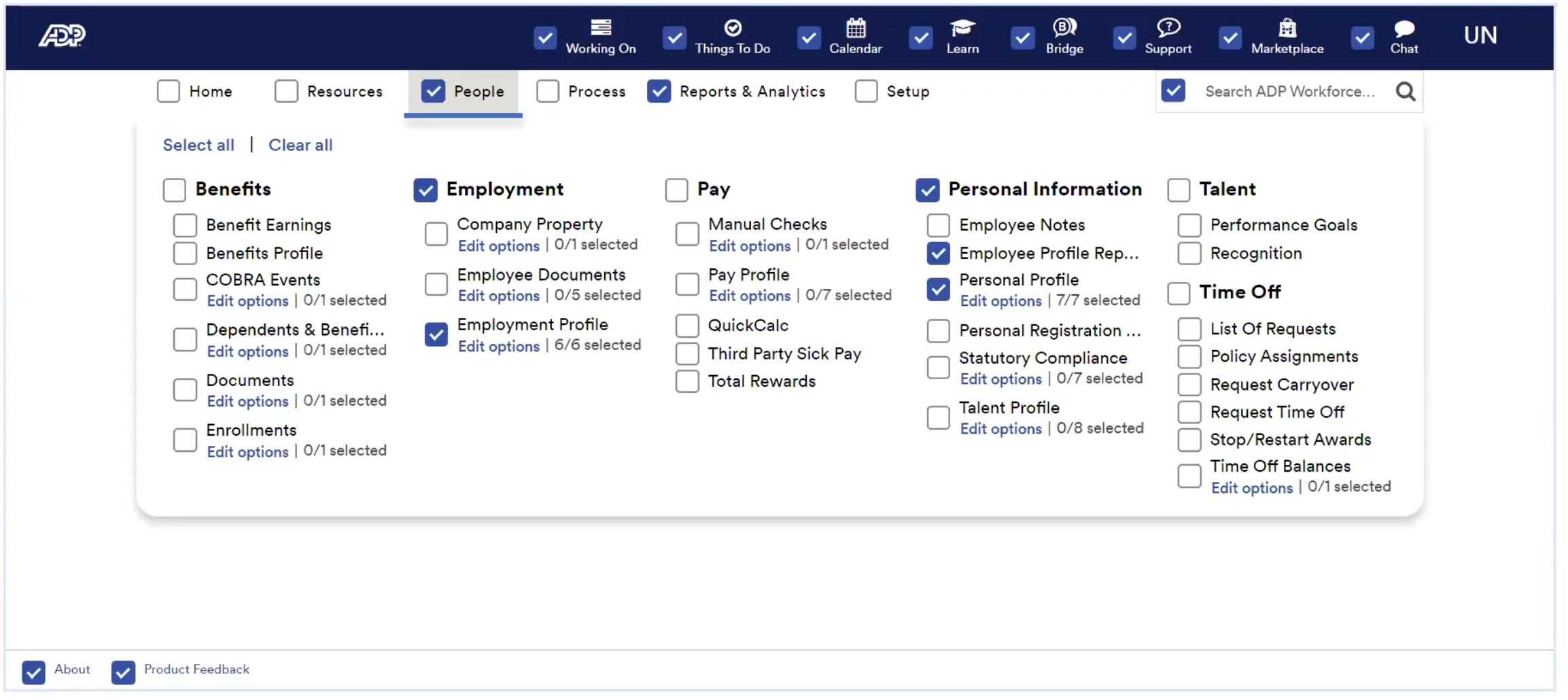
- If you want to sync date of birth (for instance, so you can run Birthday experiences in Dado):
In Sensitive Personal Information, go to On Screen & Reports and On Reports, and from the drop down menu select No Masking next to Birth Date masking. This will allow the service account to securely sync birth dates to Dado.

On the last screen, Status & Save, activate the profile, and then save it by pressing the blue button at the bottom
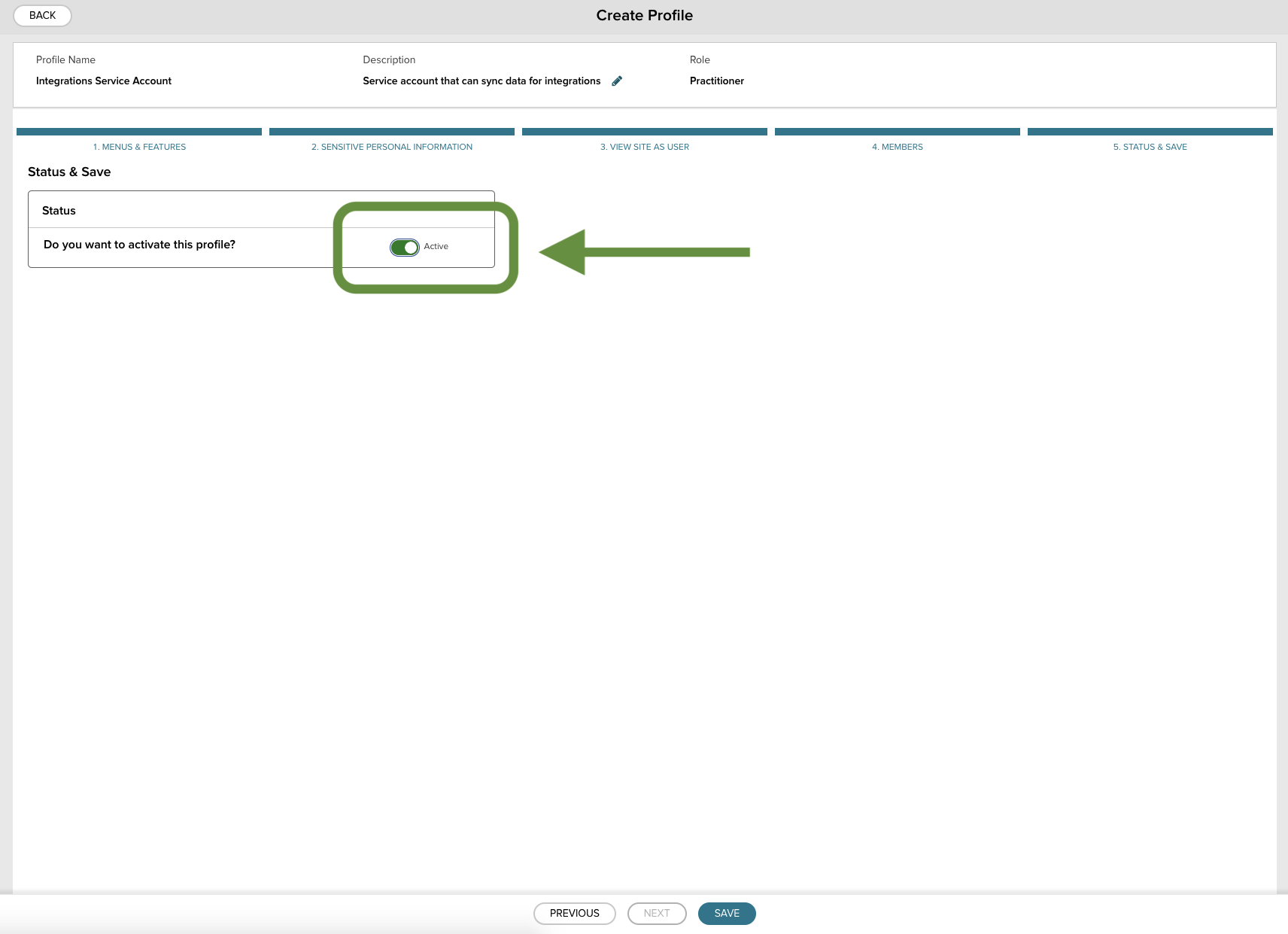
Step 3. Create a new ADP user and assign it to your "Integration Services Account" profile
From the Setup menu, select Security Management
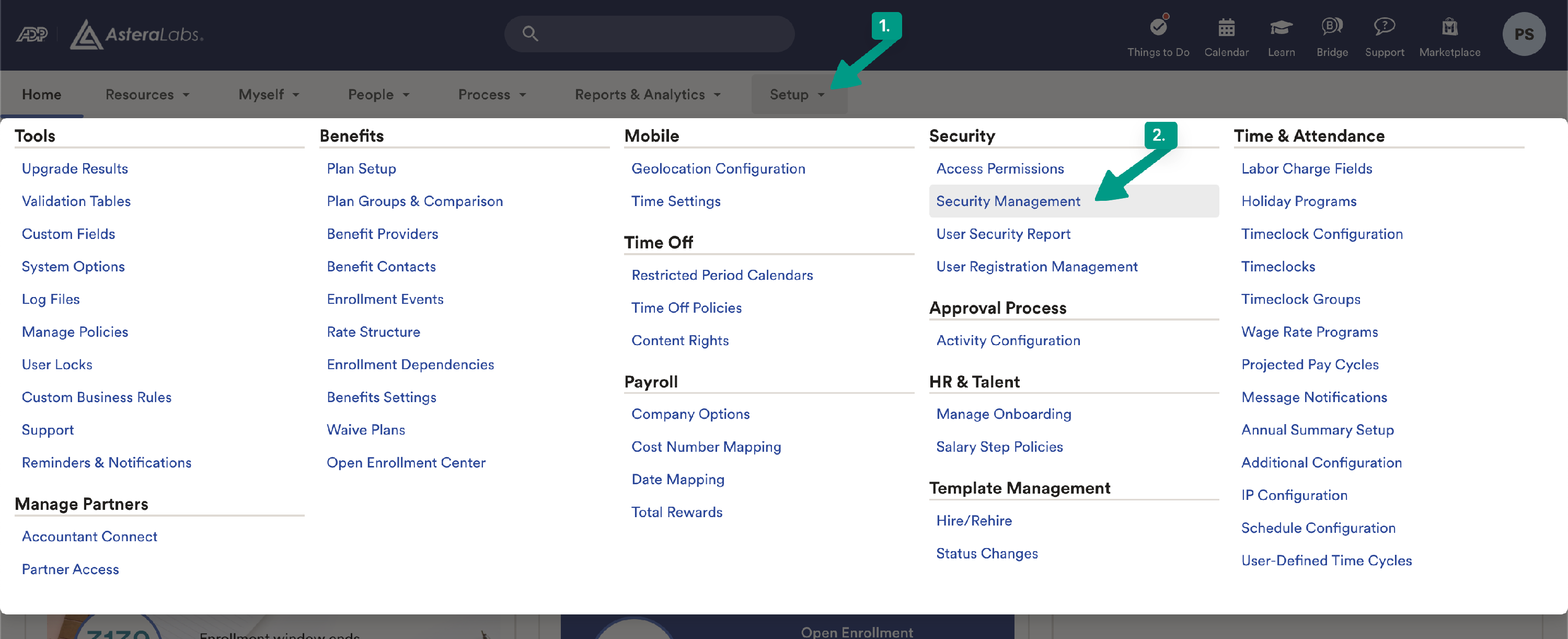
In Security Management, click People, then Manage Users and + to add a user.
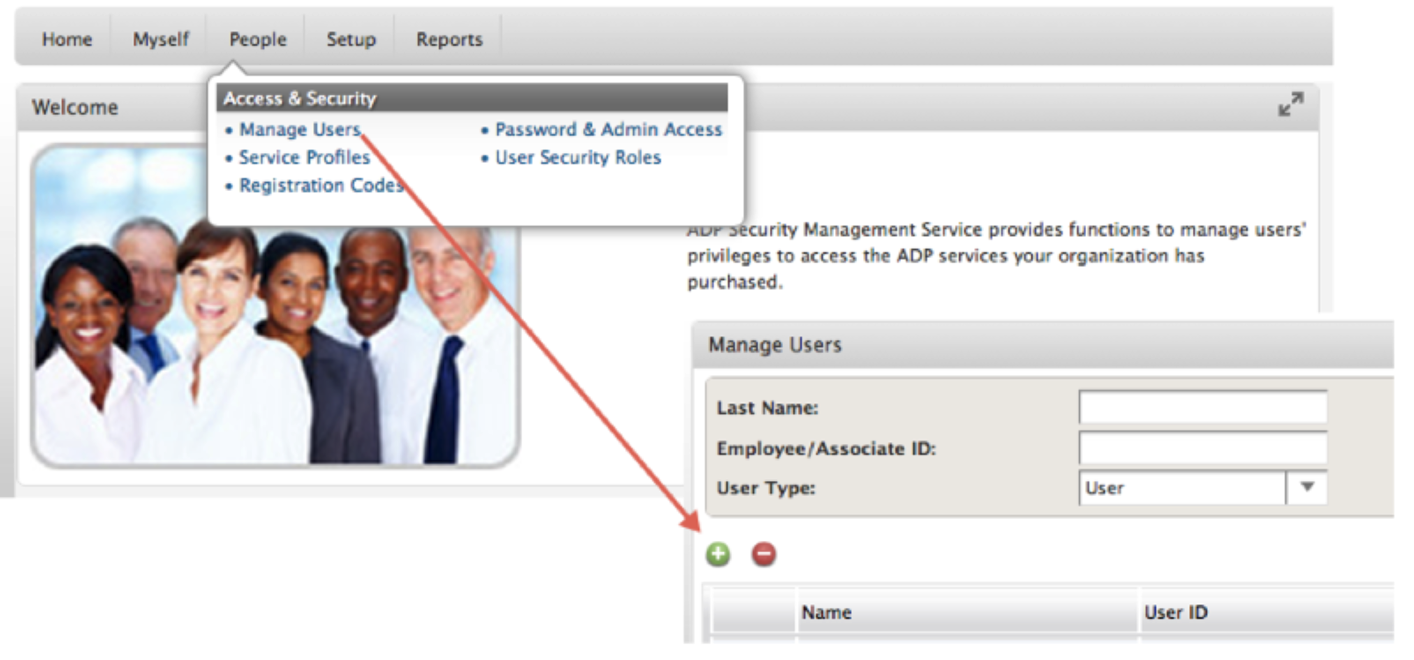
- Fill in the fields on the Add a New User page, using the info you collected from Dado in the very first step of these instructions
For Identity type select None
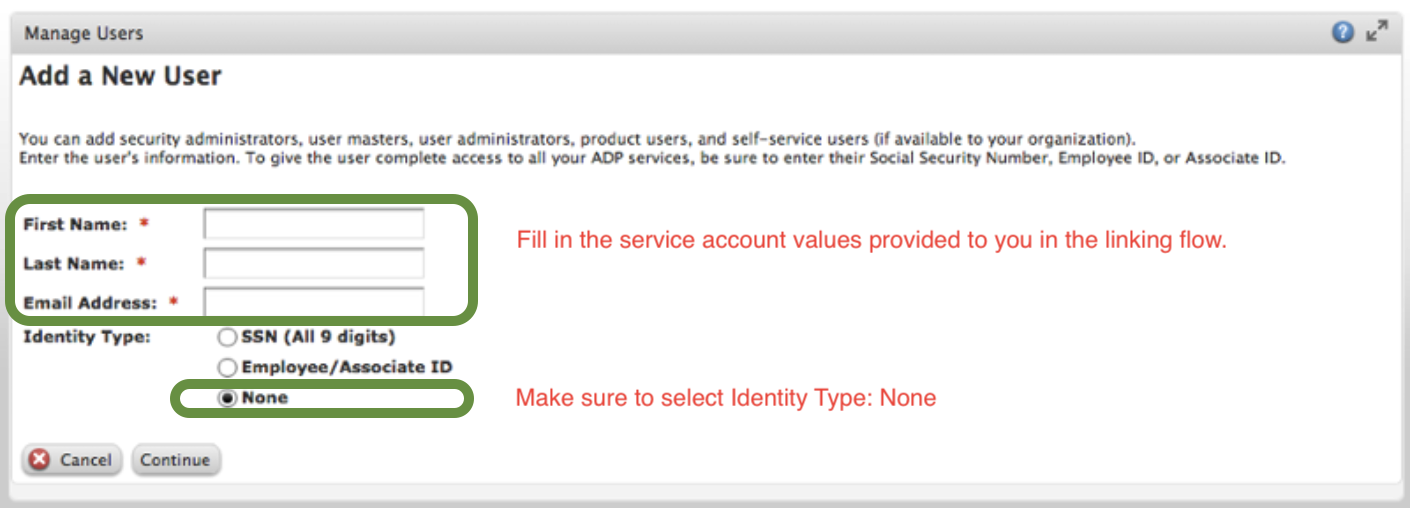
- Click Continue.
In Step 1 "User Information", set the User Type to the “user is an independent contractor...” option, and set the User Role to “Product User”.
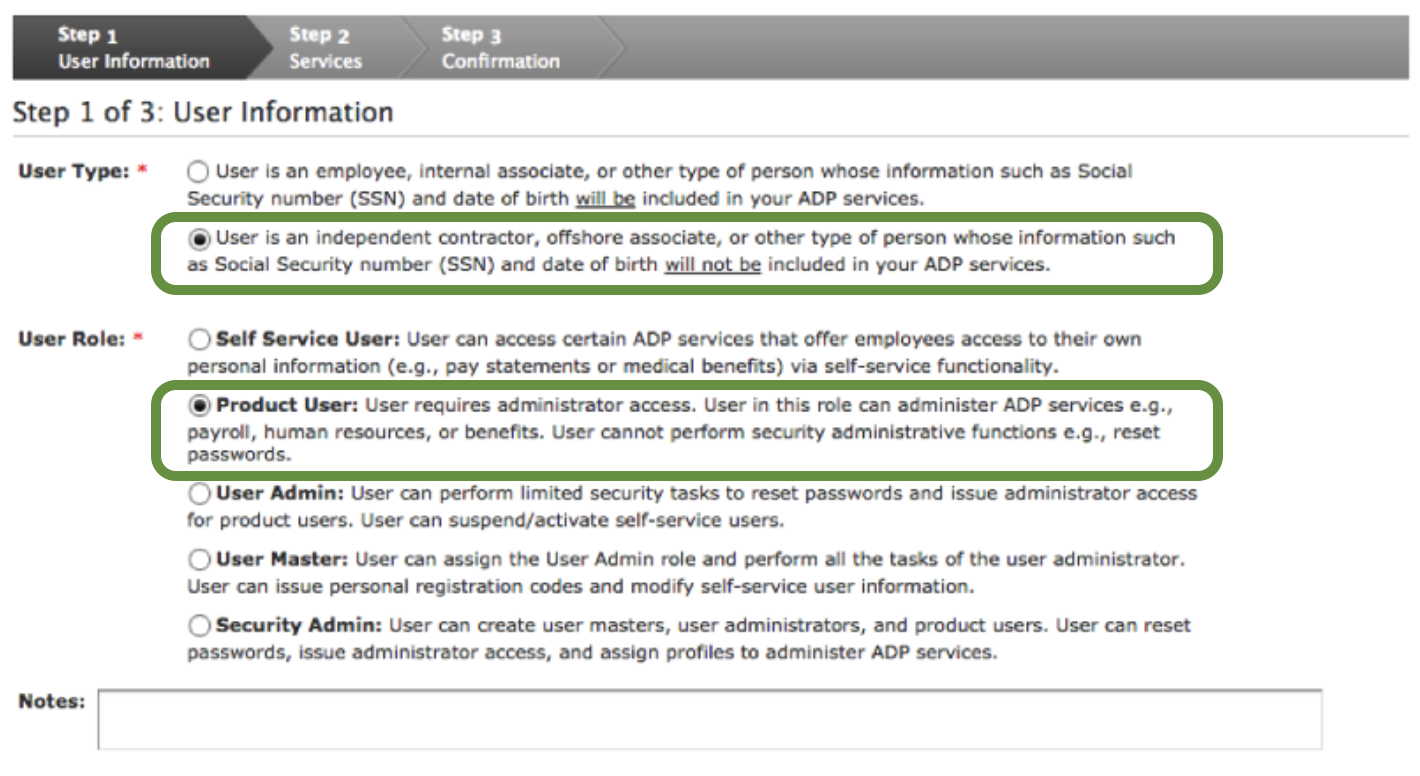
- In Step 2 "Services":
Assign the profile by selecting WFNPractitioner in the "Available Service Profiles Box" and moving it to the "Selected Service Profiles"
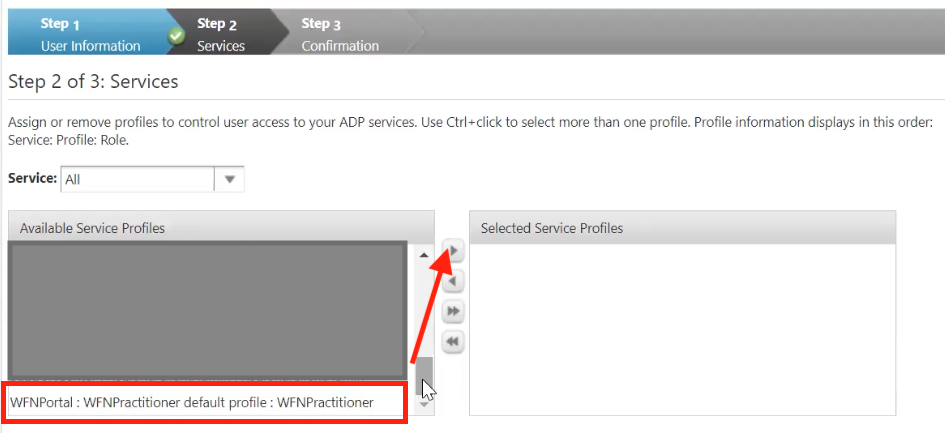
7. Proceed through Step 3, and confirm the new user.
- Please note that a username will be auto-generated for this person. That's fine.
Step 4. Connect the service account user to the service account profile you just created
Go back to your Workforce Now portal, and go to the Access Permissions page like before to find the Manage People page. Search for 'Service Account' to pull up the new user ('Service Account' should be the user's last name)

Click the user to pull up User Access Permissions, and select Manage Profile Memberships. Add the new Integration Services Account Service Account Profile that you created to the user. Click Save.
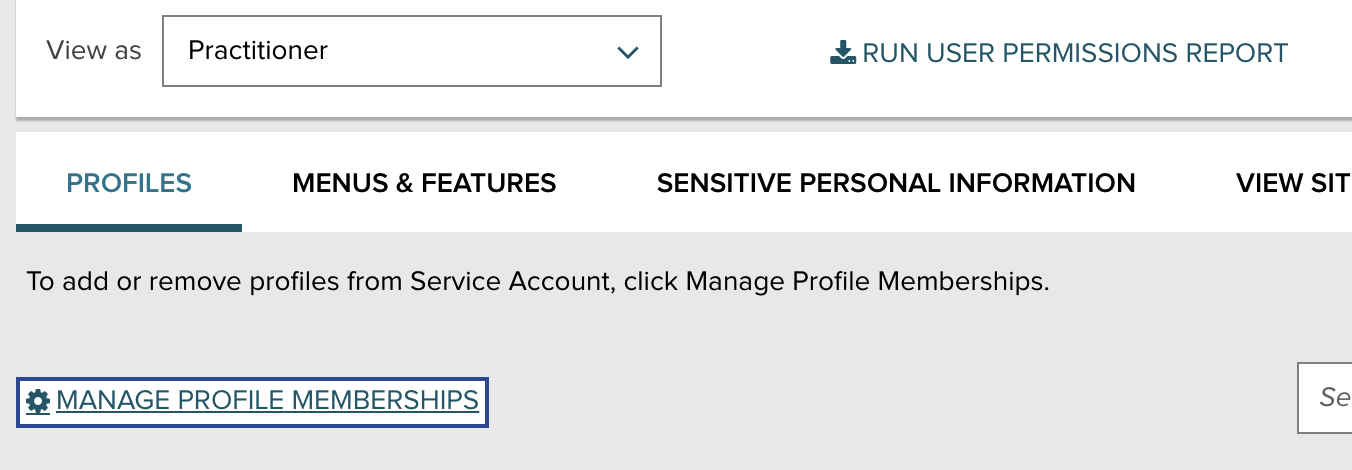
Now that the Service User has the right Profile associated, verify that the Menus & Features and Sensitive Personal Information for this user match what you set up in the Profile earlier
Lastly, in People Access, under Service Account Currently Has, check off View Only Access to all People. Click View List of Selected People, and make sure that list is not empty. This is needed to view employees (including terminated)

Step 5. Return to Dado to authenticate
- When that is all completed, return to the Dado integrations page and click on the ADP non-API card again
- Click through the steps called Administrator role required and Review your data permissions
- You will now be shown a screened called Set up a service account. Please check to be sure the service account you've just set up uses these credentials.
- If your service account has other credentials, we suggest that you create a new service account, rather than amending the existing one.
- Click Next, and then click the button on the next screen to set up the connection.
- You should see a success message indicating your integration is all set.
You're now ready to set up ADP as an import source, and start importing data into Dado!
Troubleshooting the ADP non-API integration
If Dado is unable to pull data from ADP via the non-API integration, the first thing to check is a couple of the set-up steps in ADP:
Check that the Practitioner Role has 'View Only Access to All People' checked
- In your ADP Workforce Now account, go to Setup and find Access Permissions, then go to the Manage People page

Search for 'Service Account' to pull up the dedicated user you created (whose last name should be 'Service Account')

- Click the user to pull up User Access Permissions, and select the People Access tab. Make sure that View Only Access to all People is selected.
To confirm the access has been set up correctly, click View List of Selected People, and make sure that list is not empty.

Ensure your Service Account has access to the Employee Census Report
- In your ADP Workforce Now account, go to Setup and find Access Permissions.

2. Then click Manage Profiles and select the profile you set up, which is likely called Integration Services Account.

Check the following access is granted to this profile under Reports and Analytics:
- My Reports
- All Reports
- My Standard Reports
- View
- Reports Output
- Reports Scheduled
- Reports Dashboard
- All Reports (only grants access to report types that are otherwise checked)
- Personal & Employment
- Reports Dashboard
- Reports Dashboard
- Standard Reports
- All Reports (only grants access to report types that are otherwise checked)
- Personal & Employment

- Next, go to People and make sure these boxes are checked.
- Employment:
- Employment Profile
- Personal Information:
- Employee Profile Report
Personal Profile

- Employment:












